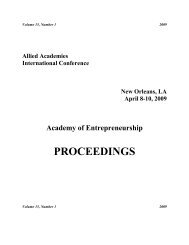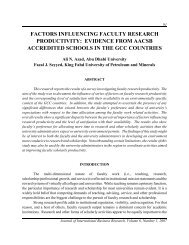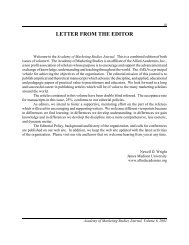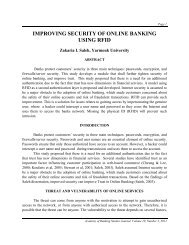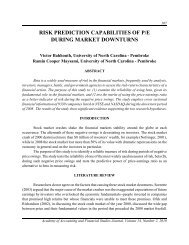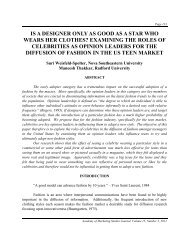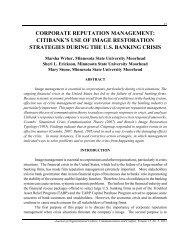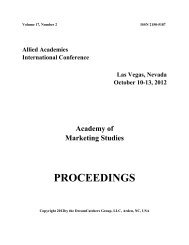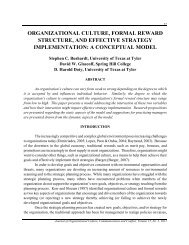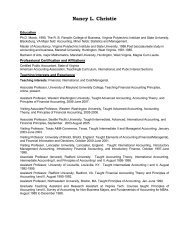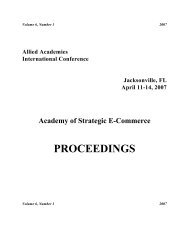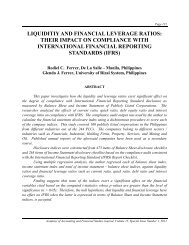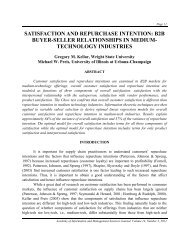HOW SALES PERSONNEL VIEW THE RELATIONSHIP BETWEEN ...
HOW SALES PERSONNEL VIEW THE RELATIONSHIP BETWEEN ...
HOW SALES PERSONNEL VIEW THE RELATIONSHIP BETWEEN ...
You also want an ePaper? Increase the reach of your titles
YUMPU automatically turns print PDFs into web optimized ePapers that Google loves.
The body of this manuscript is not reproduced in this posting. The full text of the manuscript isavailable through most university libraries. Should you have difficulty in finding the full text,you may acquire it from the original journal. Visit http://www.alliedacademies.org to find a linkto the original journal source.
107Graph 2: Graphical relationship of the impact of Spirituality on Intrinsic Satisfactionassuming a simple linear relationshipRegression PlotIS Normal = 929.680 - 0.0046577 SP Normal+ 0.0000001 SP Normal **2S = 142.320 R-Sq = 11. 6 % R-Sq (adj ) = 9. 8 %12001100IS Normal10009008007006000100002000030000SP Normal400005000060000REFERENCESAguinis, H, & Beaty, J. & Boik, R. (2005). Effect Size and Power in Assessing Moderating Effects of Categorical Variables UsingMultiple Regression: A 30-Year Review. Journal of Applied Psychology, 90 (1).Allegretti, J.G. (2000). Loving your job, finding your passion: work and the spiritual life. New York: Paulist Press.Anderson, L. & Giacalone, R. & Jurkiewicz, C. (2007). A relationship of hope and gratitude to corporate social responsibility.Journal of Business Ethics, 70(1), 401-409.Ashmos, D. & Duchon, D. (2000). Spirituality at work: A conceptualization and measure. Journal of Management Inquiry, 9(2),134-145.Bandura, A. (1986). Social Foundations of Thought and Action: A Social Cognitive Theory. Eglewood Cliffs: Prentice-Hall, 391.Baron, R.M. & Kenny, D.A. (1986). The Moderator-Mediator Variable Distinction in Social Psychological Research: Conceptual,Strategic, and Statistical Considerations. Journal of Personality and Social Psychology, 51 (6), 1173 – 1182.Benefiel, M. (2003). Mapping the terrain of spirituality in organizations research. Journal of Organizational Change Magazine,16(4), 367-376.Bhuian, S. N., Al-Shammari, E.S., & Jefri, O.A. (1996) International Journal of Commerce and Management, 57, 57-80.Brandt, E. (1996). Corporate pioneers explore spirituality. HR Magazine, 41, 82.Butts, D. (2000). Spirituality at work: and overview. In Work and Spirit: A Reader of New Spiritual Paradigms forOrganizations, 4, 35-39Journal of Organizational Culture, Communications and Conflict, Volume 15, No. 2, 2011
108Chappel, T. (1993). The soul of a business. New York: Bantam Books.Cook, J. D., Hepworth, S. J., Wall, T. D., Warr, P. B. (1981). The Experience of Work: A Compendium and Review of 249Measures and Their Use. San Diego: Academy Press.Connolly, K. & Myers, J. E. (2003). Wellness and mattering: The role of holistic factors in job satisfaction. Journal of EmploymentCounseling, 40(4), 152-160.Dehler, G. E. & Welsh, M. A. (1994). Spirituality and organizational transformation: Implications for the new managementparadigm. Journal of Managerial Psychology, 9(6), 17-26.DePree, H. (1992). Business as unusual: The people and principles at Herman Miller. Zeeland, Michigan: Doubleday Books.Downes, M., Thomas, A.S., & Singley, R.B. (2002). Predicting expatriate job satisfaction: The role of firm internationalization.Career Development International, 7, 24036.Drucker, P.F. (2003). The New Realities: In Government and Politics; in Economics and Business; in Society and World Views,New Brunswick, NJ: Transaction Publishers.Futrell, C.M. (2009). Spirituality in the salesperson: the impact of the golden rule and personal faith on workplace job attitudes.Texas A & M University Libraries.Giacolone, R. & Jurkiewicz, C. (2003). Handbook of Workplace Spirituality and Organizational Performance. New York: SpringBooks.Hair, J.F. Jr., Anderson, R.E., Tatham, R.L. & Black, W.C. (1998). Multivariate Data Analysis. New Jersey: Prentice Hall.Harrington, W. (2004, October 7-9). Worldview resiliency of business degree graduate students – An examination of spiritualexperiences and psychological attitudes. Association of Employment Practices and Principals, 119.Heaton, D. P., Schmidt-Wilk, J., & Travis, F. (2004). Constructs, methods, and measures for researching spirituality inorganizations. Journal of Organizational Change Management, 17(1), 62-82.Herzberg, F. (1968). One more time: How do you motivate employees? In S. J. Ott (Ed.), Classical readings in organizationalbehavior. 2 nd Edition. Orlando, Florida: Harcourt Brace & Company.Hilgard, E.R. (1987). Psychology in America: A Historical Survey. Harcourt Brace Jovanovich, Publishers.Hill, P, Pargament, K. (2003). Advances in the conceptualization and measurement of religion and spirituality. AmericanPsychologist Association, 58(1), 64-74.Hirschfield, R. R. (2000). Does revising the intrinsic and extrinsic subscales of the Minnesota Satisfaction Questionnaire shortform make a difference? Educational and Psychological Measurement, 60, 255-270.Judge, T. & Heller, D. & Mount, M. (2002). Five-Factor Model of Personality and Job Satisfaction: A Meta-Analysis.Journal of Applied Psychology, 87(3), 530-541.Journal of Organizational Culture, Communications and Conflict, Volume 15, No. 2, 2011
Jurkiewicz, C. L., & Giacalone, R. A. (2004). A values framework for measuring the impact of workplace spirituality onorganizational performance. Journal of Business Ethics, 49(2), 129-142.Koc, S. & Leary, D.E. (1992). A Century of Psychology as Science. Washington, D.C.: American Psychological Association.Krahnke, K., & Giacalone, R. A., & Jurkiewicz, C. L. (2003). Point-counterpoint: Measuring workplace spirituality. Journal ofOrganizational Change Management, 16(4), 396-405.Krishnakumar, S. & Neck, C. P. (2002). The “what”, “why” and “how” of spirituality in the workplace. Journal of ManagerialPsychology, 17(3), 153-164.Kumar, S.R. & Seshadri, D.V.R. (2009). Spirituality for the saleman. The Hindu group of publications. Anna Salai, Chennai.Locke, E.A. (1976). The nature and consequences of job satisfaction. In M.D. Dunnette (Ed.), Handbook of industrial andorganizational psychology. Chicago: Rand-Mcnally.Marchetti, M. (2004). Does your team need a hug or a prod ? Sales and Marketing Management, Vol.156 ; Iss 2 ;pg. 14, New York.Marques, J, & Dhiman, S. (2005). Spirituality in the workplace: Developing an integral model and a comprehensive definition.Journal of American Academy of Business, 7(1), 81-89.Maslow, A. (1954). Motivation and Personality. New York: HarperCollins.McCoy, B. (2001). CRE perspective: Living beyond the boundaries. Real Estate Issues, (2), 47-50.McLaughlin, C. (1998, March 17). Spirituality at work. The Bridging Tree, 1, 11.Milliman, J., Ferguson, J., Trickett, D., & Condemi, B. (1999). Spirit and community at Southwest Airlines: An investigation ofa spiritual values-based mode. Journal of Organizational Change Management, 12 (3), 221.Mitroff, I & Denton, E. (1999). A Study of Spirituality in the Workplace. Sloan Management Review, 40(4), 83-92.Mitroff, I., & Denton, E. (1999). A spiritual audit of corporate America: A hard look at spirituality, religion, and values in theworkplace (1 st ed.). San Francisco: Jossey-Bass Publishers.Moore, T. W. & Casper, W. J. (2006). An examination of proxy measures of workplace spirituality: A profile model ofmultidimensional constructs. Journal of Leadership & Organizational Studies, 12(4), 109-118.Mowday, R. T., Porter, L. W., Steers, R. M. (1979). The measurement of organizational commitment. Journal of VocationalBehavior, 14, 224-247.Neck, C. P. & Manz, C. C. (1992). Thought self-leadership: The influence of self-talk and mental imagery on performance. Journalof Organizational Behaviour, 13, 681-699.Neck, C. P. & Milliman, J. F. (1994). Thought self-leadership: Finding spiritual fulfillment in organizational life. Journal ofManagement Psychology, 9(6), 9-16.109Journal of Organizational Culture, Communications and Conflict, Volume 15, No. 2, 2011
110Nunnally, J. (1978). Psychometric Theory. New York: McGraw-Hill.Peters, L.H., Jackofsky, E. F., & Salter, J.R. (1981). Predicting turnover: a comparison of part-time and full-time employees. Journalof Occupational Behavior, 2, 89-98.Reed, P. (1987). Spirituality and well-being in terminally ill hospitalized adults. Research in Nursing and Health, 10, 335-344.Reed, P.G. (1991). Self-transcendence and mental health in oldest-old adults. Nursing Research, 40, 7-11.Reed, P.G. (1991). Spirituality and mental health of older adults: Extant knowledge for nursing. Family andCommunity Health, 14(2), 14-25.Reed, P.G. (1992). An emerging paradigm for the investigation of spirituality in nursing. Research in Nursing andHealth, 15, 349-357.Rego, A. & Cunha, M.P. (2008). Workplace spirituality and organizational commitment: an empirical study,Journal of organizational change management, Vol. 21, Iss 1; pg. 53. Bradford, G.B.Serifsoy, I. (2002). A humanistic approach to sales psychology. Saybrook Graduate School of Research Center, pg.92, California.Snedecor, G.W. and Cochran, W.G. (1996). Statistical Methods (8th Edition). Iowa States University PressSpector, P. E. (1997). Job satisfaction: Application, Assessment, Causes, and Consequences. California: SagePublications.Steuker, S & de Ruyter, K (2004). Reconsidering Nonlinearity and Asymmetry in Customer Satisfaction andLoyalty Models: An Empirical Study in Three Retail Service Settings. Marketing Letters. 15 (2-3).July, 99– 111.Weber, M. (2003). The Protestant Ethic and the Spirit of Capitalism. Dover Publications.Weiss, D. Dawes, R. England, G. & Lofquist, H. (1967). Manual for the Minnesota Satisfaction Questionnaire .Minneapolis: University of Minnesota, Industrial Relations CenterJournal of Organizational Culture, Communications and Conflict, Volume 15, No. 2, 2011



